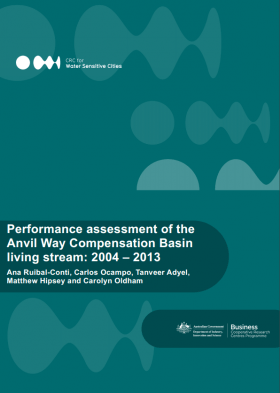Performance assessment of the Anvil Way Compensation Basin living stream: 2004-2013
Abstract
This report summarises the results of a performance assessment of the Anvil Way Compensation Basin (AWCB) restoration project. AWCB is an artificial wetland on the Swan Coastal Plain of Western Australia with an area of 9,000 m2 and maximum volume of 11,400 m3. It was constructed to improve the quality of urban and industrial stormwater runoff and reduce nutrients and other contaminants entering the Canning River via the Mills Street Main Drain (MSMD), which has an overall catchment area of 12 km2. AWCB sits relatively high in the Mills Street catchment and has a variable contributing area due to a network of upstream compensation basins in the upstream basins. The contributing area ranges from 1.8 km2 (permanently connected sub-catchments) to 3.6 km2 (when all the upstream compensation basins are connected to AWCB). The site was restored in November 2010 and reshaped with a meandering low flow path and associated vegetation. The system has been the subject of regular monitoring of hydrology, water quality andecology for the past 10 years - pre and post implementation of the restoration efforts. Since the restoration, the wetland system has also been called a “living stream” and both names are used interchangeably in this report.
This report covers an analysis of all available historical data that has been collected over the past decade with an overarching aim of gaining insights into the overall effectiveness of the wetland in treating urban stormwater. In particular, the data analysis was undertaken to evaluate the changes that occurred after construction of the living stream. It attempts to give answers to a series of knowledge gaps related to the dynamics and performance of the urban wetland and recommends future monitoring and research activities.
